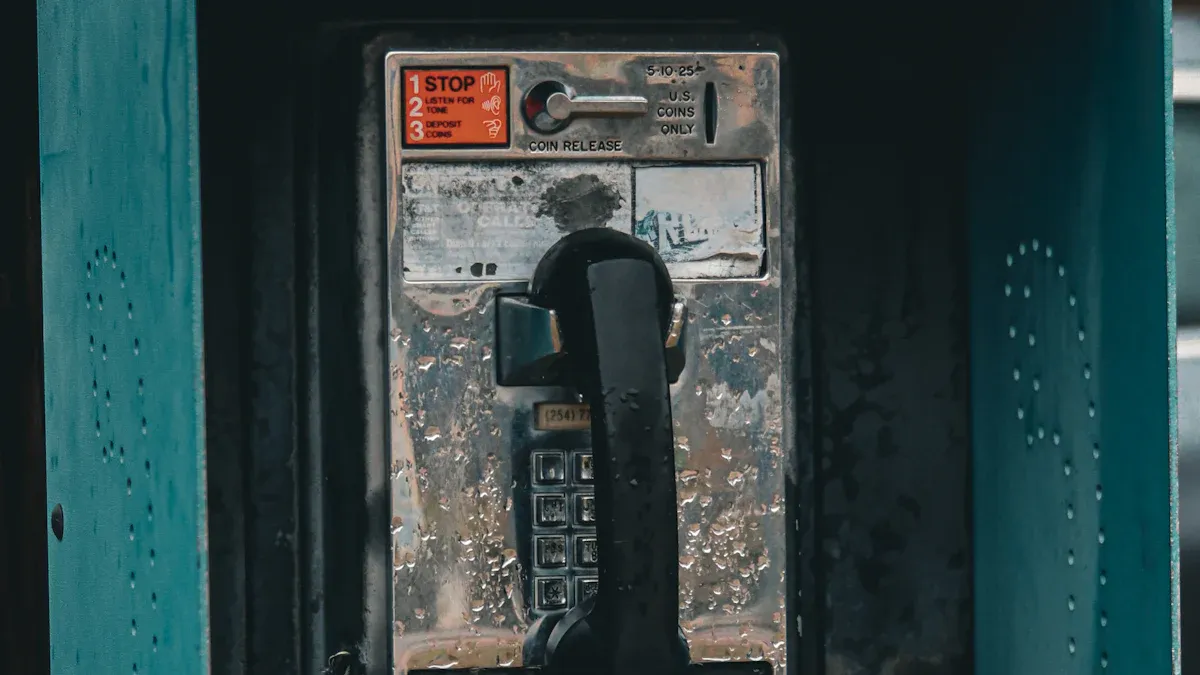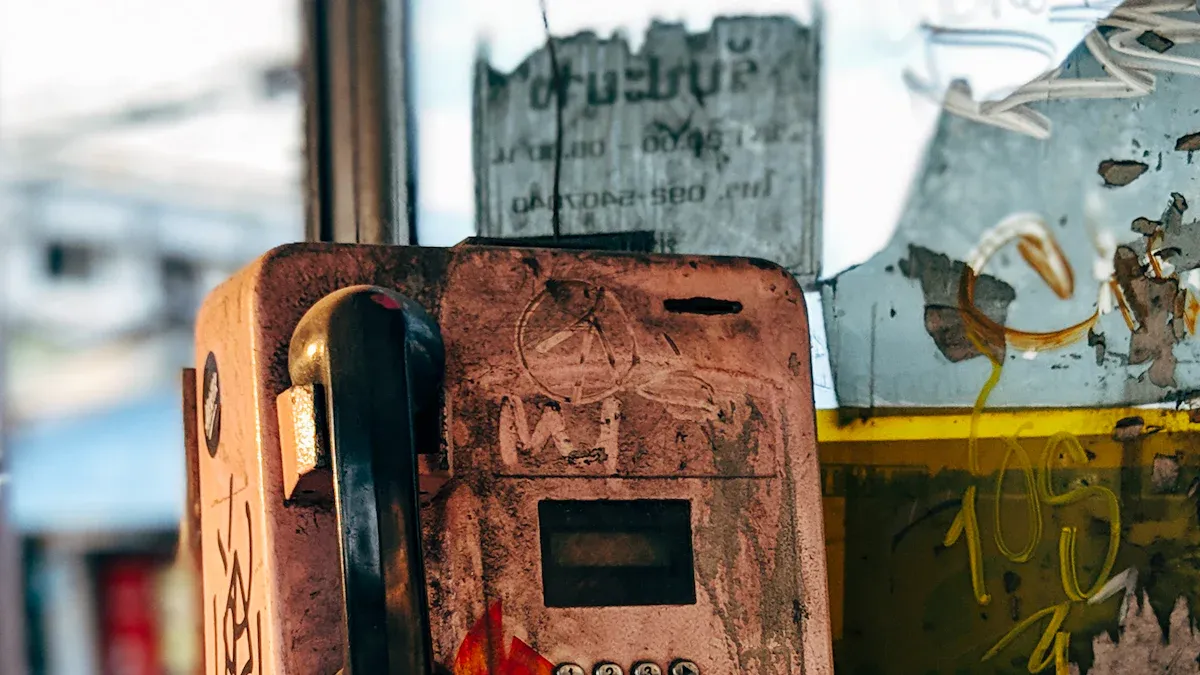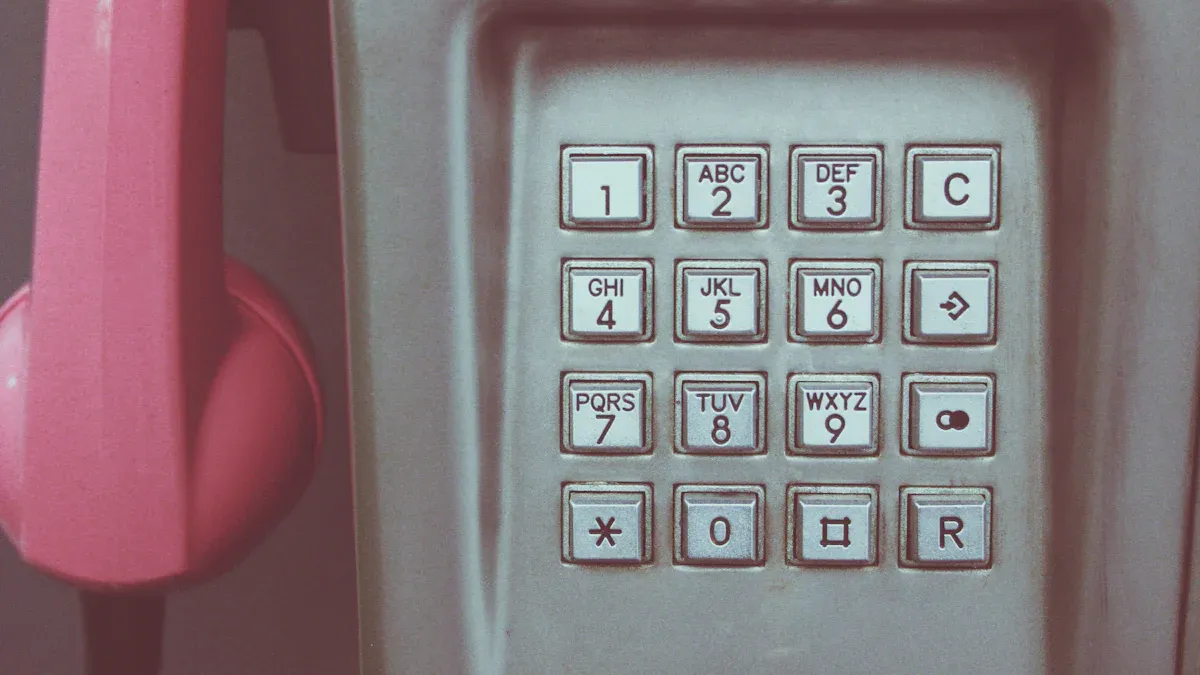
Outdoor environments demand reliable communication tools, and analog weatherproof telephones have become indispensable in such settings. From ensuring safety in mining operations with mining industrial telephones to withstanding harsh weather during emergencies with rainproof weatherproof telephones, their impact is undeniable. With features like IP68 industrial telephones and rainproof designs, these devices excel in durability, functionality, and resilience, even in extreme conditions.
Key Features of an Analog Weatherproof Telephone

Understanding Weatherproof Ratings (IP and NEMA Standards)
When choosing an analog weatherproof telephone, understanding weatherproof ratings is crucial. These ratings, such as IP (Ingress Protection) and NEMA (National Electrical Manufacturers Association), indicate how well a device can withstand environmental factors like dust, water, and other elements.
The IP rating system, defined by the ANSI/IEC 60529-2020 standard, uses two digits to classify protection levels. The first digit represents protection against solid objects, while the second digit indicates resistance to liquids. For example, an IP68 rating ensures complete dust protection and the ability to function underwater for extended periods.
NEMA ratings, on the other hand, focus on enclosures for electrical equipment. The NEMA BI 50014 – 2024 standard compares these enclosures with IP ratings, offering a broader perspective on durability.
| Standard | Description |
|---|---|
| NEMA BI 50014 – 2024 | Compares NEMA 250 Enclosures for Electrical Equipment with IEC 60529 Degrees of Protection. |
| ANSI/IEC 60529-2020 | Classifies degrees of protection provided by enclosures for electrical equipment up to 72.5 kV. |
By understanding these ratings, users can select a telephone that meets their specific environmental needs, ensuring reliability in harsh conditions.
Material Durability and Corrosion Resistance
Outdoor environments can be unforgiving, exposing devices to extreme weather, moisture, and corrosive substances. That’s why the material used in an analog weatherproof telephone plays a vital role in its longevity. High-quality materials like stainless steel, aluminum alloys, or polycarbonate are commonly used for their durability and resistance to rust or corrosion.
For instance, telephones designed for industrial use often feature anti-corrosive coatings to withstand exposure to chemicals or saltwater. This makes them ideal for marine environments, chemical plants, or mining operations. A durable build ensures the device remains functional even after years of exposure to harsh elements, reducing maintenance costs and downtime.
Audio Quality and Noise Cancellation Features
Clear communication is essential, especially in noisy outdoor settings. Analog weatherproof telephones often come equipped with advanced audio features to ensure sound clarity. Noise cancellation technology filters out background noise, making conversations more intelligible even in environments like construction sites or factories.
Independent benchmarks, such as the MTF (Modulation Transfer Function) test, measure speech intelligibility and sound quality. According to research, the B&K RASTI system uses noise bandwidths and gate speeds to replicate speech features, ensuring optimal clarity.
“The MTF test results correlate directly with Speech Intelligibility, which is a measurement of sound quality in speech. The B&K RASTI system uses 2 octave wide noise bandwidths and a variety of gate speeds to replicate the salient features of speech.”
Some models, like the JREX106-A03, boast sound levels of up to 120 dB, making them suitable for high-noise environments. Here’s a quick comparison of sound levels across various models:
| Model | Sound Level | Protection Rating |
|---|---|---|
| JREX106-A03 | 110 dB – 120 dB | II 2G Rx e ib [ib] mb IIC T6 Gb |
| INDUPHONE | 110 dB | N/A |
| ATHOS | 90 dB | N/A |
| TAD02 | 95 dB | N/A |
With these features, analog weatherproof telephones ensure reliable communication, even in the most challenging conditions.
Considerações ambientais para uso ao ar livre

Temperature Tolerance in Extreme Conditions
Outdoor environments often subject devices to extreme temperatures, from freezing winters to scorching summers. Analog weatherproof telephones are built to handle these challenges. Manufacturers test these devices using methods like thermal shock and thermal soak. Thermal shock tests simulate rapid temperature changes to identify potential failures, while thermal soak exposes the hardware to prolonged high temperatures to assess durability.
| Test Type | Purpose | Key Details |
|---|---|---|
| Temperature and Humidity | Tests electronic products under varying humidity and temperature cycles | Evaluates performance under extreme conditions, with specific temperature and humidity benchmarks. |
| Thermal Shock | Identifies mechanical and electrical failures due to rapid temperature changes | Tests PCBA functionality under extreme temperature shifts. |
| Thermal Soak | Accelerates hardware aging to evaluate longevity | Exposes devices to high temperatures for extended periods, revealing potential weaknesses. |
These rigorous tests ensure that analog weatherproof telephones remain reliable, even in the harshest climates.
Resistance to Dust, Water, and Corrosive Chemicals
Dust storms, heavy rain, and exposure to corrosive chemicals can wreak havoc on outdoor communication devices. Analog weatherproof telephones are designed to resist these elements. Many models feature IP-rated protection, such as IP66, which guarantees complete dust resistance and protection against powerful water jets.
For environments like marine docks or chemical plants, corrosion-resistant materials like stainless steel or coated aluminum are essential. These materials prevent rust and degradation, ensuring the device’s longevity. Whether it’s a mining site or a coastal area, these telephones deliver consistent performance.
| Application Area | Key Features |
|---|---|
| Manufacturing Facilities | Designed to handle dust, vibration, and rough handling. |
| Marine and Coastal Environments | Corrosion-resistant properties for prolonged exposure to moisture and salt. |
| Mining and Oil Rigs | Dustproof and explosion-proof for extreme conditions. |
| Power and Utility Stations | Weather-sealed for communication in changing weather and environmental pollutants. |
Mounting and Installation Options for Harsh Environments
Proper installation is critical for ensuring the functionality of analog weatherproof telephones in tough conditions. These devices often come with flexible mounting options, including wall-mounted, pole-mounted, or flush-mounted designs. Wall-mounted models are ideal for compact spaces, while pole-mounted options work well in open areas like construction sites.
Additionally, installation kits often include weather-sealed enclosures to protect internal components. This ensures that the telephone remains operational, even when exposed to heavy rain or strong winds. By choosing the right mounting option, users can optimize both accessibility and durability.
Functional Requirements of Analog Weatherproof Telephones
Power Source Options (Battery, Wired, or Solar-Powered)
Analog weatherproof telephones offer versatile power options to suit different outdoor environments. Battery-powered models are ideal for remote locations where electrical infrastructure is unavailable. These phones often feature long-lasting batteries, ensuring uninterrupted communication during emergencies. Wired options, on the other hand, provide consistent power through direct electrical connections, making them reliable for industrial sites or utility stations.
For eco-conscious users or areas with abundant sunlight, solar-powered telephones are a game-changer. These devices harness solar energy to operate, reducing dependency on traditional power sources. Solar-powered models are particularly useful in remote expeditions or disaster-prone regions where power outages are common.
| Feature | Details |
|---|---|
| Enclosure | High-impact, Non-metallic |
| Temperature Range | -40°F to +140°F |
| Auto Dial | Up to 31 Digits |
| Mount Location | Surface-Mount |
| Hearing Aid Compatible | Yes |
| Volume Control | Yes, with Noise-canceling Mic |
| Weatherproof Rating | NEMA 3R |
| Output Level Ringer | 84dBA @ 2 ft. |
| Dimensions | 7.4 in x 9.4 in x 13.2 in |
| Weight | 10 lb |
| Certification | UL/CSA, FCC, IC |
These power options ensure analog weatherproof telephones remain functional in diverse outdoor conditions.
Connectivity and Compatibility with Modern Systems
Modern outdoor communication demands seamless integration with advanced systems. Analog weatherproof telephones excel in this area, offering compatibility with both analog and digital networks. For instance, systems like the Zenitel Integrated Communication System (ICS 6200) support interfaces such as trunk lines, E1/T1, analog, IP, and E&M 2-wire connections.
- The Zenitel ICS 6200 enables network connections and remote service.
- It integrates with IP-based systems, ensuring adaptability to evolving technologies.
- Compatibility with analog and digital systems makes these telephones versatile for various industries.
Additionally, technical specifications like the VG420’s support for fax, modem, and multiple communication protocols further enhance connectivity. This flexibility ensures that analog weatherproof telephones can meet the demands of modern communication infrastructure.
Emergency Features for Outdoor Safety
Safety is paramount in outdoor environments, and analog weatherproof telephones are equipped with essential emergency features. These devices play a critical role during natural disasters like hurricanes, earthquakes, and floods, where traditional communication networks may fail.
- Satellite-enabled models provide reliable communication in remote areas.
- Maritime and aviation applications ensure safety in oceanic and aerial regions.
- Auto-dial functionality allows users to quickly contact emergency services, saving valuable time during crises.
For adventurers and researchers in isolated locations, these telephones act as lifelines, offering dependable communication when it matters most. Their robust design and emergency preparedness features make them indispensable tools for outdoor safety.
How to Evaluate and Compare Analog Weatherproof Telephones
Assessing Brand Reputation and Customer Reviews
Choosing the right analog weatherproof telephone starts with understanding the brand’s reputation. Established manufacturers often have a proven track record of delivering reliable products. Brands like Zenitel and JREX are known for their durable designs and advanced features, making them popular choices in industries like mining and marine operations.
Customer reviews provide valuable insights into real-world performance. They highlight strengths and weaknesses that may not be apparent from product descriptions. For example, users often comment on ease of installation, audio clarity, and durability under extreme conditions.
Tip: Look for reviews that mention long-term use in harsh environments. These can reveal how well the telephone holds up over time.
Online platforms like Amazon and industry-specific forums are great places to find detailed feedback. By combining brand reputation with customer experiences, buyers can make informed decisions.
Warranty, Support Services, and National Standards Compliance
A solid warranty and reliable support services are essential when investing in an analog weatherproof telephone. Leading manufacturers typically offer warranties ranging from one to three years, covering defects in materials and workmanship. This provides peace of mind and reduces the risk of unexpected repair costs.
Support services also play a crucial role. Brands that offer 24/7 technical assistance ensure quick resolution of issues, minimizing downtime. Some manufacturers even provide on-site support for installation and maintenance, which can be a lifesaver in remote locations.
Compliance with national standards is another critical factor. Telephones that meet certifications like UL, CSA, or FCC guarantee safety and performance. For example, UL-certified models undergo rigorous testing to ensure they can withstand extreme temperatures and environmental hazards.
Note: Always check the warranty terms and support availability before purchasing. These factors can significantly impact the overall value of the product.
Cost vs. Value: Balancing Budget and Features
Balancing cost and value is key when comparing analog weatherproof telephones. While upfront costs may seem high, it’s important to consider long-term savings and efficiency. Traditional phone systems often require dedicated staff for management, increasing operational expenses. In contrast, VoIP systems reduce complexity and staffing needs, making them more cost-effective.
Here’s a quick comparison of cost-related factors:
- Traditional systems rely on expensive copper wiring, while VoIP uses existing internet connections, cutting installation costs.
- VoIP systems offer easy scalability, allowing businesses to pay only for the lines they need.
- Long-distance calls are cheaper with VoIP, avoiding the high costs of traditional telephony networks.
Although transitioning to VoIP incurs some initial expenses, the long-term savings and improved efficiency make it a worthwhile investment. Buyers should evaluate their specific needs and choose a model that offers the best balance of features and affordability.
Tip: Don’t just focus on the price tag. Consider factors like durability, compatibility, and emergency features to ensure you’re getting the most value for your money.
Choosing the right analog weatherproof telephone involves understanding its features and matching them to the environment. Durability, weather resistance, and emergency capabilities are key. Buyers should evaluate their needs and explore trusted brands. A well-chosen model ensures reliable communication, even in the harshest conditions, making it an essential outdoor tool.
FAQ
What makes analog weatherproof telephones different from regular phones?
Analog weatherproof telephones are built for harsh environments. They resist extreme weather, dust, and water. Their durable materials and emergency features ensure reliable communication outdoors.
Can these telephones work in remote areas without electricity?
Yes! Many models offer battery or solar-powered options. These features make them perfect for remote locations where traditional power sources aren’t available.
How do I maintain an analog weatherproof telephone?
Regularly clean the exterior to remove dirt or corrosive substances. Check for wear on seals and connections. Follow the manufacturer’s guidelines for optimal performance and longevity.
Tip: Always inspect the phone after severe weather to ensure it remains functional.


